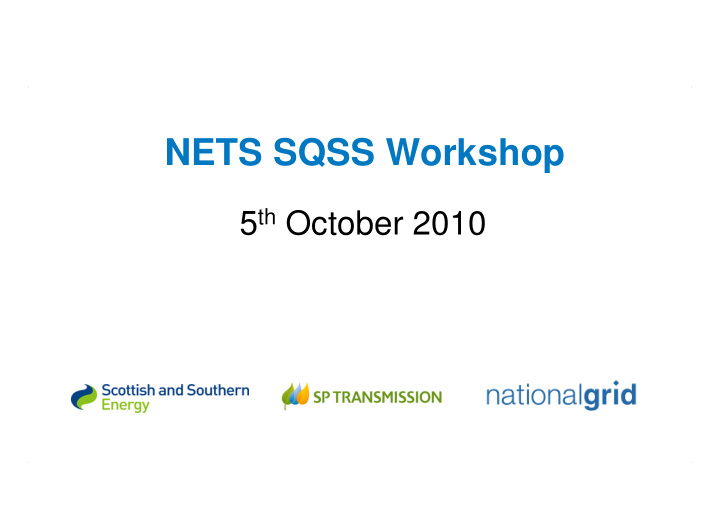



NETS SQSS Workshop 5 th October 2010
Agenda 1. Introductions 2. SQSS overview 3. Review to date � Largest Infeed loss � Fundamental review � Integration of wind 4. Future Governance 5. Future areas for review � TO proposals � Discussion 6. Industry involvement 7. Next steps 8. AOB
SQSS overview
SQSS overview � Standard based on a number of separate CEGB/Scottish standards � Initially applied to development of onshore networks � Update in 2009 to include early off-shore developments � Deterministic rules to identify compliant boundary capabilities � Further reinforcement allowed if economically justified
SQSS overview � Standard has separate chapters addressing: � Generation Connections � Demand Connections � MITS design � MITS operation � Offshore design � Offshore operation
Review to date
Review to date � A number of reviews started in 2007 and later � GSR001, Onshore intermittent generation � GSR002, Housekeeping � GSR003, Generation Connection Design � GSR004, Bus coupler security � GSR005, Voltage criteria � GSR006, Transient stability criteria � GSR007, Largest Infeed Loss � GSR008, Fundamental Review � GSR009, Integration of intermittent generation
Largest Infeed Loss - GSR007 � Recommendations: � Raise infrequent infeed loss from 1320MW to 1800MW � Raise normal infeed loss from 1000MW to 1320MW � Consulted February 2009 and recommended implementation to Ofgem � Charging consultation in response to Ofgem request � At that time, GSR007 recommended: � Start date set to coincide with connection of first >1320MW unit � More than 1320MW generation on a transmission spur excluded until start date
Revised GSR007 Start Date � Increased number of applications leading to >1320MW generation on transmission spurs � Now proposed to bring start date forward to April 2014 � Open letter 17 September 2010, responses by 8 October
Fundamental Review - GSR008 � Started 2008 and included (uncompleted) reviews � GSR001, Onshore intermittent generation � GSR004, Bus coupler security � GSR005, Voltage criteria � GSR006, Transient stability criteria � Working groups: 1. International benchmarking 2. Transmission Entry/Exit 3. MITS (Main Interconnected Transmission System) 4. Planning and operational contingency criteria 5. Offshore transmission (to include Round 3)
Fundamental Review Progress � Report published April 2010 � Significant progress and conclusions on areas such as: � Minimum generation connection criteria � Voltage criteria � Transient stability criteria � Eliminating regional variations � P2/6 alignment � Further work recommended � GSR003 group wound down based on WG2 proposals � Development of wind generation integration criteria now urgent
Wind Integration – GSR009 � Working group set up in March 2010 � Industry workshop and consultation in June 2010 � Dual criteria approach recommended to consider demand security and economics � Consultation on SQSS wording/text issued 1 October 2010 (responses by 29 October)
Governance
Governance – current arrangements � TO licence requirement – specifies SQSS version � Standard owned by NGET, SPT, SHETL � Governance arrangements voluntary � Introduced in May 2007 � Review Group comprised of Owners � Ofgem can be represented, but not a party � No other industry representation � Any interested party can request review
Governance – why change? � OFTOs � Ownership � Representation on Review Group � Number of licences � Need for clear, formal modifications process? � Clearer amendment process leads to smaller, better defined issues and faster resolution � Potential to have multiple versions of standard
Governance – current models � Grid Code � NGET licence requirement to have in force � User licence requirement to comply with � Owned by NGET � Panel with whole industry representation � Anyone on panel can request review � Proposals generally worked up by working group � Only NGET can propose modifications to Ofgem – report on different views � Modification timescales often long
Governance – current models � CUSC � Everyone has licence requirement for compliance � Owned by industry � NGET administers � Anyone can make change proposals to Ofgem � Often have multiple alternative options proposed � Generally shorter timescales to develop proposals
Governance – current models � STC � Licence requirement for TOs to comply � Owned by 3 TOs � OFTOs will have licence requirement � Will have 2 representatives on STC panel � All can make proposals to Ofgem – objections noted
Governance - options � Adopt an existing model � Create new, hybrid, arrangements � Govern alongside one of other codes
Governance – next steps � Review Group discussing options � Will welcome proposals from industry � Consult with industry on recommendations this year � Aim to report to Ofgem December / January
Recommend
More recommend